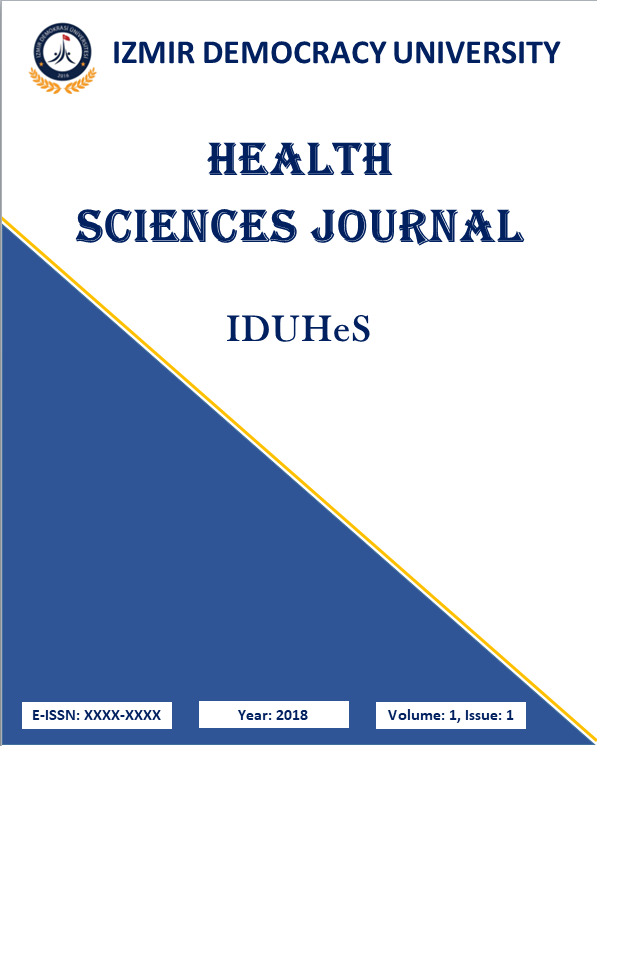İNMELİ HASTALAR İÇİN POSTÜRAL DEĞERLENDİRME ÖLÇEĞİ (POSTURAL ASSESMENT SCALE FOR STROKE PATIENTS) TÜRKÇE VERSİYONU GEÇERLİK VE GÜVENİRLİĞİ
Hemipleji, Stroke, Postüral denge, Geçerlik ve Güvenirlik
___
- Algun, C. Z. (2014). Fizyoterapi ve Rehabilitasyon. İstanbul, Nobel Tıp Kitabevleri, 397-420.
- Badke MB., Sherman J., Boyne P., Page S., Dunning K. (2011). Tongue-based biofeedback for balance in stroke: results of an 8-week pilot study. Arch Phys Med Rehabil., 92: 1364-70.
- Beaton DE, Bombardier C, Guillemin F, Ferraz MB. (2000). Guidelines for the process of crosscultural adaptation of self-report measures. Spine. 25 (24): 3186-91.
- Benaim, C., Pérennou, D. A., Villy, J., Rousseaux, M., & Pelissier, J. Y. (1999). Validation of a standardized assessment of postural control in stroke patients the Postural Assessment Scale for Stroke Patients (PASS). Stroke, 30(9): 1862-1868.
- Berg KO., Wood-Dauphinee S., Williams JI., Gayton D. (1989). Measuringbalance in the elderly: preliminary development of an instrument. Physiother Can; 41: 304-11.
- Cabanas-Valdes R, Girabent-Farres M, Canovas-Verge D, Caballero-Gomez FM, German- Romero A, Bagur-Calafat C. (Feb 2015). Spanish translation and validation of the Postural Assessment Scale for Stroke Patients (PASS) to assess balance and postural control in adult post- stroke patients. Rev Neurol; 16; 60(4): 151-8.
- Chien CW, Hu MH, Tang PF, Sheu CF, Hsieh CL. (2007). A comparison of psychometric properties of the smart balance master system and the postural assessment scale for stroke in people who have had mild stroke. Arch Phys Med Rehabil; 88: 374–380.
- Gillen G., Burkhardt. A. (2004). Balance impairment. (Ed. Donato S., Pulaski KH.), Stroke rehabilitation. St Louis: Mosby, 145-62.
- Hsueh IP., Chen KL., Chou YT., Wang YH., Hsieh CL. (Oct, 2013). Individual-level responsiveness of the original and short from postural assessment scale for stroke patients. Phys Ther; 93(10): 1377-82.
- Huang CY., Song CY., Chen KL., Chen YM., Lu WS., Hsueh IP.,Hsieh CL. (2016). Validation and Establishment of an Interval-Level Measure of the Balance Assesssment in Sitting and Standing Positions in Patients With Stroke. Arch Phys Med Rehabil; 97(6): 938-46.
- Kucukdeveci, A. A., Yavuzer, G., Tennant, A., Suldur, N., Sonel, B., & Arasil, T. (2000). Adaptation of the modified Barthel Index for use in physical medicine and rehabilitation in Turkey. Scandinavian Journal of Rehabilitation Medicine; 32(2): 87-92.
- Liaw LJ., Hsieh CL., Lo SK., Chen HM., Lee S., Lin JH. (2008). The relative and absolute reliability of two balance performance measures in chronic stroke patients. Disabil Rehabil; 30(9): 656-61
- Lih-Jiun Liaw, Ching-Lin Hsieh, Sing-Kai Lo, Hui-Mei Chen, Su Lee& Professor Jau-Hong Lin. (2008). The relative and absolute reliability of two balance performance measures in chronic stroke patients. Journal Disability and Rehabilition; 30(9): 656-661.
- Öge E. A.(Ed), Baykan B. (Ed), Bahar S. Z. (Yrd Ed). (2004). Nöroloji. İstanbul, Nobel Tıp Kitabevi, 19-24.
- Parlak Demir Y., Yıldırım SA. (Jan 2015). Reliability and validity of Trunk Control Test in patients with neuromuscular diseases. Physiother Theory Pract; 31(1): 39-44.
- Persson, U. C. (2012). The Modified Version of the Postural Assessment Scale for Stroke Patients. Measurement properties and a longitudinal follow-up. Institute of Neuroscience and Physiology, Sahlgrenska Academy, University of Gothenburg, Göteborg, Sweden. ss.89-91 Woolley SM. (2001). Characteristics of gait in hemiplegia. Journal Topics in Stroke Rehabil, Toledo, 7: 1-18.
- Yu WH., Hsueh IP., Hou WH., Wang YH., Hsieh CL. (Feb, 2012). A comparison of responsiveness and predictive validity of two balance measures in patients with stroke. J Rehabil Med; 44(2): 176-80.
- Yayın Aralığı: Yılda 3 Sayı
- Başlangıç: 2018
- Yayıncı: İzmir Demokrasi Üniversitesi
DIABETES MELLITUS’UN KOMPLİKASYONLARI
ADÖLESAN YAŞ GRUBUNDA İZOLE TUBAL TORSİYONUN LAPAROSKOPİK DETORSİYONU
YAŞLILIKTA DİYABETİN DİĞER BİR YÜZÜ: DİYABETİK RETİNOPATİ ve DÜŞMELER
Elif DUYGU, Özlem ÇINAR ÖZDEMİR
Sibel ZÖNGÜR, Cihan Caner AKSOY, Ferruh TAŞPINAR, Betül TAŞPINAR, Banu KENAR
